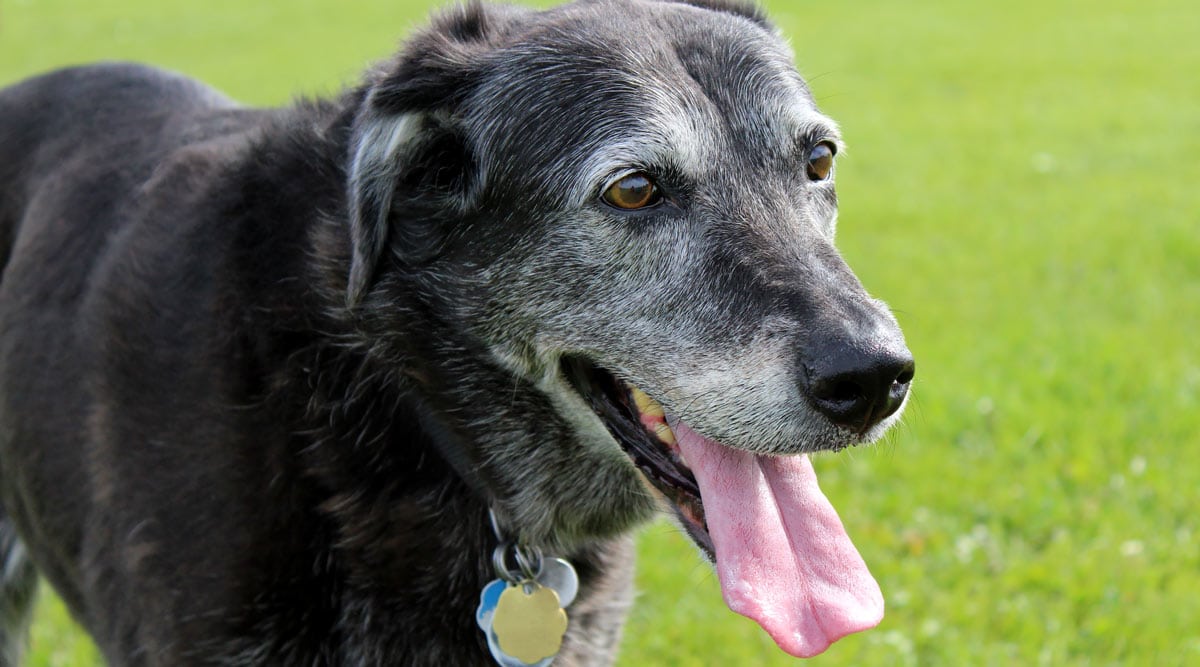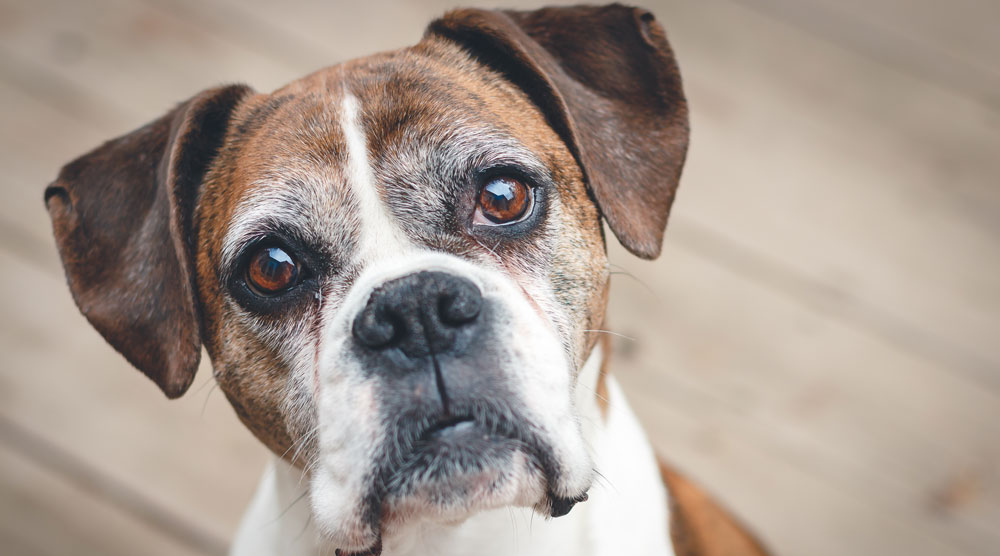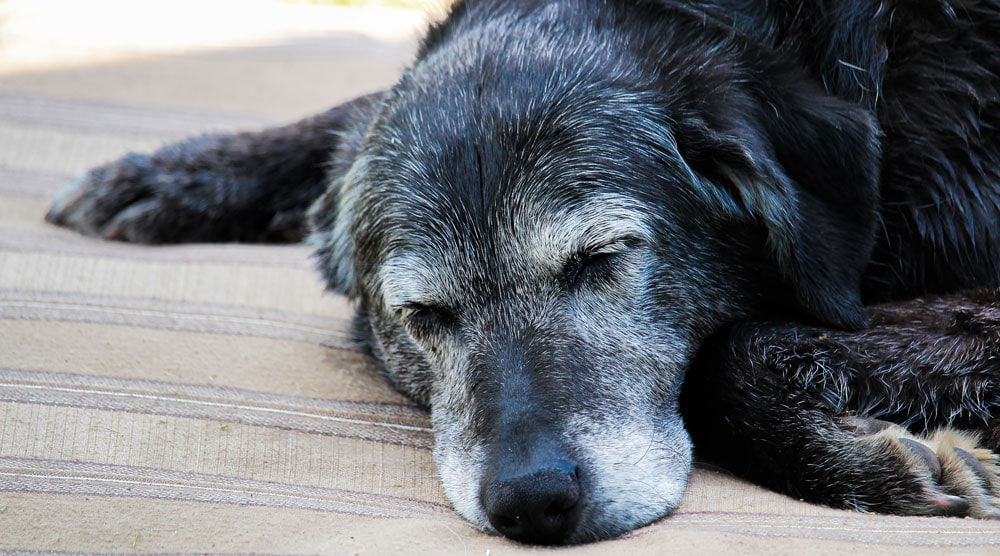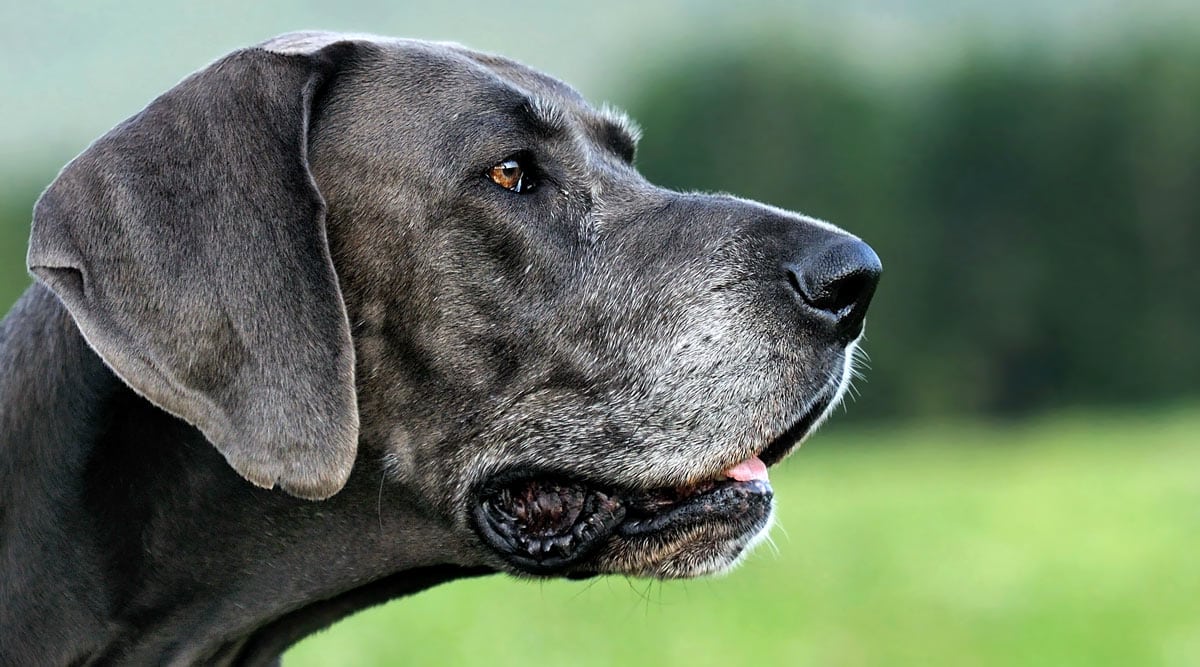Canine dementia is a condition that’s similar to Alzheimer’s in humans. It can cause a range of symptoms that are sometimes difficult for dog owners to spot or understand. We asked veterinary surgeon Dr. Linda Simon to explain more about the common signs of this condition, what causes it, and how it affects her client’s dogs.
It is not unusual for me to diagnose canine dementia in the senior dogs I see in my clinic. Oftentimes, the owner is aware there is an issue, but may not know canine dementia can now be diagnosed in our pets.
While this condition is progressive and not one which we can cure, there are many things we can do to make our dogs more content and comfortable in the latter part of their life. I find that the earlier we can see the dog and start making adjustments, the better we can help them to cope.
Contents
What is Canine Dementia?
Canine dementia, also known as canine cognitive dysfunction (CCD), is comparable to dementia in people. As your dog’s brain ages, you may notice changes in their behaviour, anxiety levels and ability to retain information.
While research is ongoing into why canine dementia occurs, it is thought to be linked to a build-up of amyloid proteins within the brain and a reduced blood flow locally. There may well be a genetic component.
Estimates suggest that up to one-third of dogs over the age of 11 will be affected, though not all will have obvious signs. The severity will vary from one dog to the next, as will the speed with which their signs progress.
6 Signs a Dog Might Have Canine Dementia
As canine dementia affects the brain, this condition has a wide range of potential symptoms. Here are six that I often see in my veterinary practice though.
1. Confusion
Confusion is a common sign that a senior dog might be suffering from canine dementia.
It can be alarming when your dog suddenly becomes confused in a familiar area, like their home or garden. They may act disorientated, unsure where the doors are or walking back and forth.
You may also notice confusion when your dog with dementia meets a human. For example, they may have known the person for a long time, but don’t seem to find them familiar. They may be wary of them and could take much longer than normal to remember who they are and to ‘warm up’ to them.
2. Irritability
Dogs who have dementia are frequently more irritable and can even become snappy. They may socialise less and move themselves away from the family and other pets, getting more space from the noise.
However, not all irritability should be automatically attributed to canine dementia. These reactions could also be caused by chronic pain, such as joint disease or a rotten tooth. I’ll always perform a ‘nose to tail’ check when an owner brings in their older dog who has recently become irritable.
3. Trouble Sleeping
Many of my patients with canine dementia will stop sleeping through the night and can find it hard to fall asleep. Their sleep pattern can become irregular and you might find they sleep more at day time and less at night time.
Again, sleep trouble is not only caused by dementia, and we need to consider that an older dog may not be sleeping well due to an underlying medical issue like arthritis. For some dogs, sleep can be hugely improved with some pain relief and a cosy, orthopaedic bed.
4. Barking For No Reason
For many owners I speak to, barking is one of the more frustrating signs of doggy dementia. Dogs may bark for hours on end aimlessly, with their barking typically occurring more when they’re alone and at night time.
This barking can be a result of confusion as well as deteriorating hearing. They may be ‘calling’ for you when they are struggling to fall asleep and are unsettled in the dark.
Related Article: Why Is My Dog Barking At Nothing?
5. Staring Blankly
Some patients with canine dementia may ‘stare into space’ and look blankly at things like walls or doors. This is classed as ‘disorientation’ and can be quite upsetting to watch.
When observing these dogs, it seems as though they are unsure of where to go or what to do next. So instead of making a decision, they choose to stay still and stare into the distance.
6. Reluctance To Play Or Engage With People
One of the more upsetting signs of canine dementia is that your older companion may lose their desire to engage and become withdrawn. Even those who were once outgoing and confident might not be interested in the games and toys that they used to love.
Though some loss of interest in playing is expected as a dog ages, the change can be marked in those with dementia. Many owners will tell me it has been years since their senior dog brought them a toy, asking them to play.
Is Canine Dementia Treatable?
Sadly, we cannot cure or reverse canine dementia, nor can we stop it from happening. However, we can try to slow down its progression and make the affected dog’s life as easy as possible.
The first step is to confirm the diagnosis with a general vet check. Some vets may use a questionnaire or ‘dementia scale,’ such as the CADES scale (1), to measure the severity and progression of the disease.
The vet assessment should also include some basic tests such as an orthopaedic exam and blood test. These can rule out other possible issues that can mimic dementia, such as advanced arthritis, an underactive thyroid, or toxin build up due to liver or kidney disease.
Medical Options
You should always discuss your dog’s treatments with your vet, as every case is different and requires a unique approach.
With that said, two of the most common things I prescribe my patients are a supplement to support brain function and a medicine called Vivitonin.
- Aktivait, one of the better-known supplements on the market, contains ingredients such as Omega 3 fatty acids, L-Carnitine, Co-enzyme Q10 and Phosphatidylserine. These ingredients work to support brain function and prevent free radical damage within the brain. They are given daily with food.
- Vivitonin can help improve circulation and can give older dogs a new ‘pep in their step’. It is specifically aimed at dogs who are acting dull and lethargic, and it can help improve their engagement in activities and general energy levels. Most dogs are given tablets twice daily with food.
Lifestyle Adjustments
As well as nutritional supplements and medication, it is important that we adapt the environment to suit the dog.
Physical and mental stimulation are both vital for a senior dog’s wellbeing. They can also help to keep the dog active and prevent depression. Several studies have proven the ‘use it or lose it’ theory, showing that providing enrichment can help maintain cognitive function.
Enrichment can be in the form of brain games, new food puzzles, walks along new routes and mini training sessions. Remember not to expect too much from your senior dog, taking things at their pace and rewarding them when they engage with lots of praise and treats.
Familiarity is also essential for making a dog with dementia feel more comfortable. I always recommend that owners of dogs with dementia try to keep their routine as predictable as possible. Where you can, this means offering meals and walks at a similar time each day. Similarly, we want to avoid a big disruption to the dogs’ schedule, like a stay in kennels or leaving them for a prolonged period of time.
For those with diagnosed dementia, they crave routine and can become very unsettled if things change abruptly.




